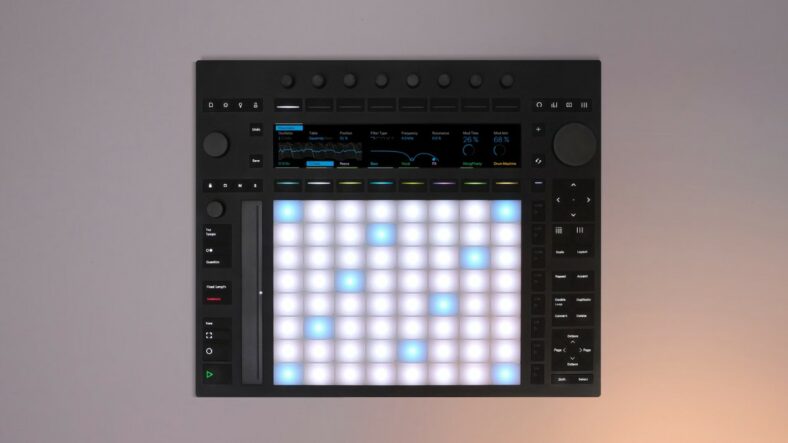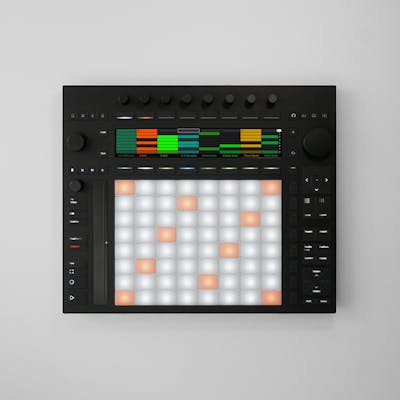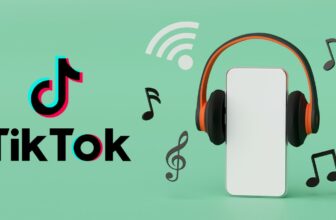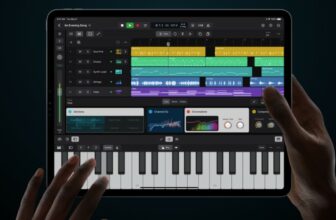Is the Ableton Push 3 Worth It?

The Push 3 comes in two versions (standard and standalone) and is one of the most ambitious products ever released by Ableton. Due to its many new features and improvements, Push 3 is miles away from its predecessor. But… is it worth buying?
If you’re considering getting Ableton Push 3, you’ve come to the right place! Below, you can find everything you need to know about one of the hottest electronic instruments of the hour. But before getting into detail, check out the major differences between Ableton Push 2 and Ableton Push 3:
Major differences between Push 2 and Push 3
- Push 3 standalone can be used without a computer, Push 2 does not.
- Push 3 features a built-in audio interface, Push 2 does not.
- Push 3 is MPE-compatible, while Push 2 isn’t.
- Push 3 includes an enhanced jog wheel and other new workflow features.
Here’s a great video by ELPHNT giving a demo and run-through of the Ableton Push 3:
Contents
What’s the difference between Ableton Push 3 and Ableton Push 3 standalone?
The difference between Ableton Push 3 and Ableton Push 3 standalone is that the latter can be used without being connected to a computer. Unlike the standard version, the standalone version of Push 3 includes the following:
- A built-in Intel 11th-generation i3-1115G4 processor with 8GB of RAM;
- A built-in 256GB SSD hard drive;
- A battery with up to 2.5 hours of battery life;
- Wi-Fi connection.
Due to the additional hardware, Push 3 standalone is more expensive than the standard version. It also includes a pre-installed version of Ableton Live Intro.
While Ableton Push 3 standalone is certainly a step forward (it’s been something that Ableton users have been requesting for many years), Tobi Hunke (the man behind abletondrummer.com, who is a very well-respected Ableton Live instructor and developer of countless amazing max for live plugin) summed up his perspective on it:
“I would say it really depends on HOW and WHAT FOR you are using Ableton Live to judge IF the Ableton Push 3 is right for you. It is great for quickly sketching ideas but as soon as you go sequencing the Stand-Alone would mean going back and forth to the PC/Mac – Which still IS a step forward but not quite the stand-alone experience I would say.”
Tobi Hunke (abletondrummer.com)
Tobi has some critical points about the current version of the Ableton Push Standalone, including that it binds you to a specific workflow, has limitations and lack of clarity regarding future updates on Max for Live, missing core features, and has some basic issues with recording and live performance. To learn more about his perspective on it, check out Tobi’s Ableton Push 3 review or watch his video below.
What’s new in Ableton Push 3?
Ableton Push 2 is a revered MIDI instrument that’s perfectly adapted to Ableton Live. Push 3 maintains most of the attributes of its predecessor and is only slightly different in terms of usability and workflow. However, it’s packed with new, game-changing features such as:
- A standalone version: Unlike Push 2, Push 3 has a standalone version that doesn’t need to be connected to a computer.
- A built-in audio interface: Unlike Push 2, Push 3 allows you to record audio without an external interface. The Push 3 built-in audio interface can be found both in the standard and standalone versions.
- USB MIDI interface: Unlike Push 2, Push 3 allows you to seamlessly connect USB MIDI devices with no need for external hardware, both in the standard and standalone versions.
- MPE integration: Both Push 2 and Push 3 include 64 high-quality pads for expressive playing, but the pads in Push 3 are MPE-enabled. Here’s an overview of what MPE can do for you.
- Updates and support: Unlike Push 2, which is no longer in production, Push 3 is fully supported and updated by Ableton.
These are the headline differences between Ableton Push 2 and 3, but there’s more! Continue reading for an in-depth comparison of the two products.
Ableton Push 3 vs. Ableton Push 2
You already have Ableton Push 2, and it’s been working like a charm for years now. So, why should you invest a ton of money in Ableton Push 3? Is it really going to make a difference in your music production? Or does it fall short in terms of new features and improvements?
Interface
The interfaces of Ableton Push 2 and 3 are pretty similar, but there are some differences worth noticing:
- Push 3 features an enhanced jog wheel for quick browsing and editing;
- Screen size is the same, but—unlike Push 2—Push 3 allows you to see clips on the screen;
- There’s a new center button in the middle of the Push 3 navigator arrows that works like an “Enter” and makes it faster to switch between tracks;
- Push 3 has two new dedicated knobs for adjusting volume and swing amounts;
- In Push 3, the buttons for switching between notes and session mode were repositioned and highlighted with appropriate icons;
- In Push 3, the buttons for loading a new track and starting a new MIDI capture were repositioned.
If you’ve been a longtime Push 2 user and you don’t want to change to Push 3 because you feel like you’ll have to learn a new instrument, you can kiss all of your worries goodbye! Apart from a few small adjustments, Push 3 plays just like its predecessor.
Audio interface
Whereas Push 2 doesn’t have a built-in audio interface, Push 3 features tons of options for recording audio directly into Ableton Live, both in the standard and standalone versions.
Push 3’s audio interface includes:
- Two balanced input jacks
- Two balanced output jacks
- Two footswitch jacks
- One headphone jack
- One ADAT port for up to eight additional channels of uncompressed audio.
That’s great news! But do Push 3 preamps stand up to the test?
With three preamp types (Line, Instrument, and High) and audio quality of up to 96kHz (24-bit), Push 3’s built-in audio interface is good enough to cover the vast majority of your recording needs.
MPE integration
One of the biggest updates in Push 3 is MPE integration, which allows you to play and record MIDI data that goes beyond velocity sensitivity. Thanks to an XY sensor, the 64 MPE-enabled pads in Push 3 include sliding-up and pitch-bend features for more expressive, personalized playing.
With MPE integration, up-and-down movements and pressure are fully registered as MIDI data and can be MIDI-mapped to create interesting effects in real time.
MIDI and external instruments
MIDI controllers and external instruments can be connected to Push 3 via the MIDI input and output or one of the USB ports. Note Mode allows you to play external instruments using the Push, which means you can effectively set it up as a MIDI controller too.
Portability
Since Push 3 was designed to perform live, portability is very important. Compared to Push 2, Push 3 is slightly larger; however, the difference in size doesn’t relevantly affect Push’s portability. One thing to keep in mind, though, is that the Push 3 standalone is noticeably heavier than the Push 3 standard due to the additional hardware.
Another cool new feat in Push 3 that doesn’t affect portability is the inclusion of four little “feet” that help the instrument to stand a bit higher, especially when laid down on a desk. This small change can also prevent Push 3 from heating, even though it doesn’t have that big of an impact on performance.
Compatibility
You can import old Ableton Live sets into Push 3 seamlessly, but the electronic instrument is only compatible with Ableton Live 11.3 and later.
What could be better in Ableton Push 3?
Push 3 takes on the best in Push 2 and adds a lot more stellar features to the package. However, it’s still not the perfect electronic instrument Ableton Live users have dreamed of.
Here are three things that could be better in Ableton Push 3:
- The standalone version of Push 3 only includes Ableton Live 12 Intro, which doesn’t seem fair considering the product’s price tag. For that kind of money, Ableton clients should at least be entitled to the Standard version.
- The standalone version of Push 3 isn’t compatible with VST plugins. This means that, if you choose to use the instrument without a computer, you need to freeze all VST tracks in your live set first. While Ableton Live is filled with cool instruments and audio effects, this is a definite handicap for music producers.
- Push 3 audio interface doesn’t support phantom power, meaning it’s not possible to record directly into the instrument using a condenser microphone.
What is Ableton Push?
Push is a MIDI controller/electronic instrument created by Ableton, the same company that produces the Ableton Live DAW. Since its very first release, Push has been designed to work as a physical extension of Ableton’s software. In other words, it’s the definitive instrument for Ableton Live users who are tired of looking at a computer screen.
With the standalone version of Push 3, Ableton finally fulfilled a longtime dream of Ableton Live users, empowering them with the ability to use all of the features in Live without a computer. Push 3 also has a standard version, which can be connected to a computer as if it were any other MIDI controller.
Verdict
So, is the Ableton Push 3 worth it?
Luckily for all Ableton Live users out there, Push 3 stands up to the test and delivers many new features that make it worth buying. The possibility of using Ableton Live without a computer is Push 3’s headline attribute (in the standalone version), but it’s not going to be for everyone. The built-in audio interface and new MPE-enabled pads also take recording, editing, and performing with Push to the next level.
In the end, it’s up to you to carefully evaluate what’s new in Push 3 and decide whether you should upgrade from Push 2 or not. If you don’t have an Ableton Push instrument, it’s definitely worth considering the Push 3 instead of a secondhand Push 2 (even though the latter is potentially much cheaper).
Push 3 standalone is definitely worth considering for Ableton live users that:
- Perform live routinely.
- Those are tired of using their computers.
- Those who prioritize expressive playing over in-the-box audio editing.







Hey – I would say it really depends HOW and WHAT FOR you are using Ableton Live to judge IF the Ableton Push 3 is right for you. It is great for quickly sketching ideas but as soon as you go sequencing the Stand-Alone would mean going back and forth to the PC/Mac – Which still IS a step forward but not quite the stand-alone experience I would say. Here are my thoughts/my review IF you want to share this: https://blog.abletondrummer.com/ableton-push-3-review/
Hey Tobi, thanks for your comment. I’ve updated the article here to share some of your points in more detail. Btw, your Max for Live devices are amazing. On behalf of the entire community of drummers that use Ableton Live, THANK YOU!